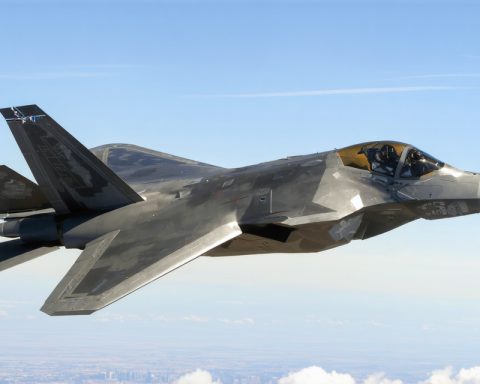- The Indian Air Force is acquiring 12 new Su-30MKI fighter jets from Hindustan Aeronautics Limited (HAL), bolstering its aerial strength.
- Valued at 13,500 million rupees, the deal aligns with India’s “Make in India” initiative by promoting local production and reducing import dependence.
- The Su-30MKI, equipped with powerful AL-31FP engines and advanced radar systems, enhances India’s air defense capabilities.
- Production at HAL’s Nashik plant is set to create jobs and foster technology transfer, further integrating India into the global defense industry.
- Criticisms exist over HAL’s delivery delays, with commitments to speed up production to meet the Indian Air Force’s operational needs.
- The acquisition strengthens India’s deterrence capability amid regional tensions and reinforces strategic ties with Russia.
- This move underscores India’s pursuit of modernizing its military and achieving self-reliance in defense.
A new chapter unfolds in India’s defense narrative as the Indian Air Force embraces a bold move to enhance its aerial prowess. The recent pact with Hindustan Aeronautics Limited (HAL) to acquire 12 sleek Su-30MKI fighter jets reinforces India’s drive towards modernizing its military muscle, valuing the deal at a staggering 13,500 million rupees.
The Su-30MKI, a formidable multi-role fighter of Russian lineage, will soar with agility through Indian skies thanks to its powerful AL-31FP engines, marrying both strength and autonomy. These fighters whisper sophistication with advanced radar and detection systems, providing the Indian Air Force with sharp eyes and ears over its airspace.
Beyond the mere acquisition, this initiative breathes life into the “Make in India” vision, thrusting the local defense industry into the global forefront. By crafting these jets at HAL’s Nashik plant, India not only strengthens its military capabilities but also ignites job creation and tech transfer, diminishing its dependency on foreign imports.
However, clouds hover over HAL due to criticisms regarding delayed timelines. The Indian Air Force’s Air Marshal Amar Preet Singh has voiced concerns over sluggish deliveries impacting operational readiness. In a bid to remedy this, HAL has pledged to expedite the production process, ensuring the Nashik assembly lines hum with renewed vigor.
As these magnificent aircraft prepare to take to the skies, India’s commitment to a modern and robust Air Force stands firm. Amid regional tensions, this deal not only fortifies India’s deterrence capabilities but also reinforces its strategic ties with Russia. This step is not just a testament to India’s defense ambition but a stride towards true self-reliance in safeguarding its skies.
Unveiling the Future: India’s Leap in Defense with the Su-30MKI Jets
How-To Steps & Life Hacks
How to Maximize the Benefits of the Su-30MKI Acquisition
1. Enhance Pilot Training: Ensure extensive and specialized training for pilots to exploit the full capabilities of the Su-30MKI, focusing on its multi-role capabilities.
2. Upgrade Support Infrastructure: Develop and modernize maintenance facilities and logistics to support these advanced aircraft, ensuring quick turnaround times for repairs and regular maintenance.
3. Leverage Technology Transfer: Utilize technology transfers from HAL’s production to enhance local manufacturing capabilities, fostering innovation within India’s aerospace sector.
Real-World Use Cases
Strategic Advantages of the Su-30MKI
– Border Defense: These jets serve as a crucial deterrent near potentially volatile borders, offering a quick-response capability.
– Extended Patrols: With aerial refueling capabilities, the Su-30MKI can undertake extended missions, maintaining vigilance over critical zones.
– Advanced Reconnaissance: Equipped with state-of-the-art avionics and radar systems, they can conduct reconnaissance missions, providing real-time data and intelligence.
Market Forecasts & Industry Trends
Growth Trends in Defense Manufacturing
– Expanding Indigenous Production: The “Make in India” initiative is expected to spur growth in local defense industries, potentially increasing India’s share in the global defense market.
– Technological Innovations: Continued investments in R&D are poised to bring innovations, particularly in avionics and radar technologies.
– Increased Export Potential: With successful domestic production, India may become a significant exporter of military aircraft to nations seeking cost-effective options.
Reviews & Comparisons
Su-30MKI vs. Other Fighters
– Versatility: Compared to contemporaries like the F-16, the Su-30MKI offers superior versatility in roles from air superiority to ground attack.
– Range and Payload: The Su-30MKI boasts a longer range and higher payload capacity than many Western counterparts, making it ideal for varied missions.
Controversies & Limitations
Challenges for HAL and the IAF
– Production Delays: Persistent delays from HAL have drawn criticism, with impacts on operational readiness being a significant concern.
– Maintenance Overheads: Maintaining advanced fighters like the Su-30MKI can be resource-intensive, requiring specialized training and facilities.
Features, Specs & Pricing
Su-30MKI Specifications
– Engine: AL-31FP turbofan engines with thrust vectoring capability.
– Armament: Equipped with a wide array of weapons, including air-to-air and air-to-surface missiles.
– Radar System: A Bars radar that offers multi-target engagement capabilities.
Pricing
– Deal Value: The acquisition is valued at 13,500 million rupees, reflecting both the cost and strategic importance of these aircraft.
Security & Sustainability
Bolstering National Security
– Enhanced Surveillance: Advanced radar and detection systems enable superior surveillance, ensuring robust national security.
Sustainability Challenges
– Carbon Footprint: Military jets contribute significantly to environmental impacts, prompting India to explore greener technologies as a future agenda.
Insights & Predictions
The Road Ahead for India’s Defense
– Adoption of AI and Robotics: Future enhancements may include AI-driven upgrades in fighter technologies and the integration of robotics in operations.
– Evolving Strategic Alliances: Continued collaborations with global powers like Russia enhance geopolitical stability and technological advancements.
Tutorials & Compatibility
Maximizing Jet Performance
– Operational Guides: Manuals and video tutorials should be developed to ensure pilot and crew proficiency in every aspect of jet operation.
Compatibility
– Interoperability: Ensuring that the Su-30MKI systems are fully compatible with existing Indian military infrastructure will be crucial for effective deployment.
Pros & Cons Overview
Advantages of the Su-30MKI
– Versatile Capabilities: Offers comprehensive multi-role capabilities.
– Technological Edge: Superior radar, detection systems, and armament.
Disadvantages
– Costly Maintenance: High operational and maintenance costs.
– Production Delays: Potential delays affecting readiness.
Actionable Recommendations
1. Prioritize Training Programs: Implement robust training initiatives for pilots and ground crew to fully utilize the Su-30MKI’s capabilities.
2. Invest in Support Infrastructure: Upgrade existing support infrastructure for maintenance and supply chain logistics.
3. Monitor Production Milestones: Encourage HAL to meet delivery timelines to ensure operational readiness, potentially incorporating performance-based incentives.
For more insights and updates on India’s defense sector, visit India’s Ministry of Defence.







